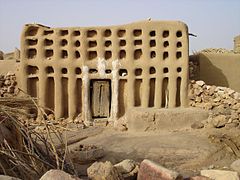
A | B | C | D | E | F | G | H | CH | I | J | K | L | M | N | O | P | Q | R | S | T | U | V | W | X | Y | Z | 0 | 1 | 2 | 3 | 4 | 5 | 6 | 7 | 8 | 9
| Part of a series on |
| Traditional African religions |
|---|
 |

A hogon is a spiritual leader in a Dogon village who plays an important role in Dogon religion.
The life of a hogon

A hogon is a religious figure as well as a temporal authority;[1] the hogon may be hereditary or may be chosen from among the village elders—custom varies from place to place. The hogon is always a man. After being chosen, a hogon must pass through several months without washing or shaving. After initiation, he wears a red cap, and a pearl bracelet. Hogon live alone and should be celibate, but a village girl may act as a maid. Nobody should touch the hogon.[2]
Ritual

The hogon has a key role in village rituals and in ensuring fertility[3] and germination.[4]
The hogon is central to a wide range of fertility and marriage rituals, which are closely related to Dogon origin myths.[5]
The hogon may conduct rituals in the Sanctuaire de Binou, a special building the door of which is blocked with rocks.[6]
Creation myth
According to legend, the first hogon, Lebe, was descended from a nommo. He was eaten by another nommo, and their spirits merged; the nommo vomited out a new Lebe (part human and part spiritual), plus copious liquid which shaped the landscape.[7]
See also
References
- ^ Imperato, Pascal James (1978). Dogon cliff dwellers: the art of Mali's mountain people. L. Kahan Gallery/African Art. p. 12.
- ^ "hogon | African religious leader | Britannica". www.britannica.com. Retrieved 2022-05-25.
- ^ Bonnefoy, Yves (1993). American, African, and Old European mythologies. University of Chicago Press. pp. 123. ISBN 978-0-226-06457-4.
- ^ Heusch, Luc de (June 1997). "Les mécanismes symboliques de la royauté sacre: à la re-découverte de Frazer". Journal of the Royal Anthropological Institute (2).
- ^ Dieterlen (1956). "Parenté et Mariage Chez les Dogon". Africa. 26 (2): 107–148. doi:10.2307/1156839. JSTOR 1156839. S2CID 145001767.
- ^ "hogon | African religious leader | Britannica". www.britannica.com. Retrieved 2022-05-25.
- ^ Imperato, Pascal James (2001). Legends, sorcerers, and enchanted lizards: door locks of the Bamana of Mali. Africana Publishing. ISBN 978-0-8419-1414-8.
Text je dostupný za podmienok Creative Commons Attribution/Share-Alike License 3.0 Unported; prípadne za ďalších podmienok. Podrobnejšie informácie nájdete na stránke Podmienky použitia.
Antropológia
Aplikované vedy
Bibliometria
Dejiny vedy
Encyklopédie
Filozofia vedy
Forenzné vedy
Humanitné vedy
Knižničná veda
Kryogenika
Kryptológia
Kulturológia
Literárna veda
Medzidisciplinárne oblasti
Metódy kvantitatívnej analýzy
Metavedy
Metodika
Text je dostupný za podmienok Creative
Commons Attribution/Share-Alike License 3.0 Unported; prípadne za ďalších
podmienok.
Podrobnejšie informácie nájdete na stránke Podmienky
použitia.
www.astronomia.sk | www.biologia.sk | www.botanika.sk | www.dejiny.sk | www.economy.sk | www.elektrotechnika.sk | www.estetika.sk | www.farmakologia.sk | www.filozofia.sk | Fyzika | www.futurologia.sk | www.genetika.sk | www.chemia.sk | www.lingvistika.sk | www.politologia.sk | www.psychologia.sk | www.sexuologia.sk | www.sociologia.sk | www.veda.sk I www.zoologia.sk

